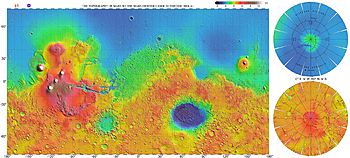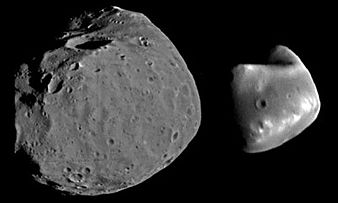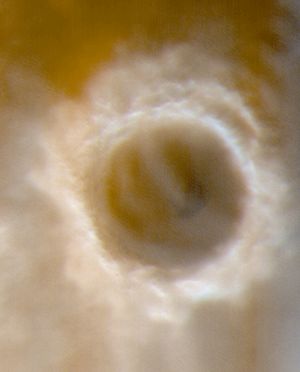North Polar Basin (Mars) facts for kids

The Borealis Basin is the large blue and green region lying north of the equator. Volcanic eruptions on the Tharsis bulge, the higher elevation region on the left of the image, covered over parts of the basin after its formation.
|
|
| Location | Northern Hemisphere, Mars |
|---|---|
| Coordinates | 67°N 208°E / 67°N 208°E |
The Borealis Basin is a huge, flat area in the northern part of Mars. It covers about 40% of the planet! Imagine a giant bowl stretching across almost half of Mars.
Scientists think this basin might have formed when a massive object, about 1,900 kilometers (1,200 miles) wide, crashed into Mars very early in its history, around 4.5 billion years ago. This would make it the biggest impact crater in our entire Solar System! However, the official group that names features on planets, the International Astronomical Union, hasn't yet said for sure that it's an impact crater.
Contents
What parts of Mars are in the Borealis Basin?
Since the Borealis Basin is so huge, many well-known areas on Mars are actually inside it. These include:
- Acidalia Planitia
- Arcadia Planitia
- Planum Boreum
- Utopia Planitia
- Vastitas Borealis
How the Borealis Basin might have formed
The giant impact theory
One popular idea for why the Borealis Basin is so flat and has few craters is that it was made by a single, giant impact. Scientists have used computer models to imagine this crash. They think it happened at a low speed, between 6 to 10 kilometers (4 to 6 miles) per second, and at a slanted angle. The object that hit Mars might have been between 1,600 to 2,700 kilometers (1,000 to 1,700 miles) wide.
Information from the Mars Global Surveyor spacecraft supports these ideas. It suggests the basin is shaped like an oval, about 10,600 kilometers (6,600 miles) long and 8,500 kilometers (5,300 miles) wide. Later, huge volcanic eruptions, like those that formed the Tharsis bulge, covered parts of the basin's edges. If this theory is true, the Borealis Basin would be much larger than any other known crater, even bigger than Utopia Planitia on Mars or the South Pole–Aitken basin on our Moon.
Such a massive impact would have melted a lot of the Martian crust. It would have also changed how heat moves inside Mars, causing more melted rock to rise to the surface. This event could even explain why the northern part of Mars doesn't have strong magnetic fields today. The shock waves from the impact might have removed the magnetism from the crust.
Could the impact have made Mars's moons?
The origin of Mars's two small moons, Phobos and Deimos (shown here), is a mystery. One idea is that they are captured asteroids. But their nearly round orbits and how close they are to Mars's equator don't quite fit this idea.
Another theory is that the moons formed from debris ejected during a giant impact on Mars. This is similar to how Earth's Moon formed. Scientists think a Borealis-sized impact could have thrown enough material into orbit around Mars to create these moons. The material would have then slowly clumped together, or accreted, to form Phobos and Deimos.
Ancient tsunamis on Mars
Scientists have found strange mineral deposits along the southern edge of the northern lowlands of Mars. These deposits look a lot like those left behind by tsunamis on Earth. This has led to an exciting idea: that ancient tsunamis once crashed across the Martian surface!
One recent study pointed to three impact craters in Acidalia Planitia as possible sources for these tsunamis. The Lomonosov crater (pictured here) is thought to be the most likely candidate. If an object hit Mars there, it could have created a tsunami up to 75 meters (250 feet) high! This giant wave would have traveled 150 kilometers (90 miles) past the southern edge of the basin.
By studying the age of these deposits, scientists believe these tsunamis happened about 3 billion years ago. This provides more evidence for the idea that Mars might have had a large ocean in its northern hemisphere long ago.
See also
 In Spanish: Cuenca Boreal (Marte) para niños
In Spanish: Cuenca Boreal (Marte) para niños
- Arctic Basin (Earth's "North Polar Basin")
- Mars ocean hypothesis (Oceanus Borealis)
- Planum Boreum
- Utopia Planitia
- Vastitas Borealis



